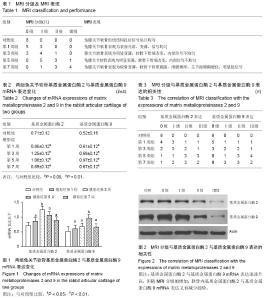| [1] Brown JP, Boulay LJ. Clinical experience with duloxetine in the management of chronic musculoskeletal pain. A focus on osteoarthritis of the knee. Ther Adv Musculoskelet Dis.2013; 5(6): 291-304.
[2] Chiba K, Osaki M, Ito M, Majumdar S. Osteoarthritis and bone structural changes. Clin Calcium 2013; 23(7): 973-981.
[3] Gudbergsen H. MRI in knee osteoarthritis. Application in diet intervention. Dan Med J 2013; 60(3):B4594.
[4] Jansen JA, Haddad FS.High prevalence of vitamin D deficiency in elderly patients with advanced osteoarthritis scheduled for total knee replacement associated with poorer preoperative functional state. Ann R Coll Surg Engl.2013; 95(8):569-572.
[5] Li Y,Wei X,Zhou J,et al. The age-related changes in cartilage and osteoarthritis. Biomed Res Int 2013; 2013:916530.
[6] Mosher DF, Adams JC.Adhesion-modulating/ matricellular ECM protein families: a structural, functional and evolutionary appraisal. Matrix Biol.2012; 31(3):155-161.
[7] Ravindran S, George A. Multifunctional ECM proteins in bone and teeth. Exp Cell Res 2014. [Epub ahead of print].
[8] Gupta A, Kaur CD, Jangdey M, et al. Matrix metalloproteinase enzymes and their naturally derived inhibitors: Novel targets in photocarcinoma therapy. Ageing Res Rev. 2014; 13C:65-74.
[9] Kast RE, Halatsch ME. Matrix metalloproteinase-2 and -9 in glioblastoma: a trio of old drugs-captopril, disulfiram and nelfinavir-are inhibitors with potential as adjunctive treatments in glioblastoma. Arch Med Res. 2012; 43(3):243-247.
[10] Lièvre A, Milet J, Carayol J,et al. Genetic polymorphisms of MMP1, MMP3 and MMP7 gene promoter and risk of colorectal adenoma. BMC Cancer. 2006; 6:270.
[11] Rengel Y, Ospelt C, Gay S. Proteinases in the joint: clinical relevance of proteinases in joint destruction. Arthritis Res Ther.2007; 9(5):221.
[12] Pelletier JP, Cooper C, Peterfy C, et al. What is the predictive value of MRI for the occurrence of knee replacement surgery in knee osteoarthritis? Ann Rheum Dis 2013; 72(10):1594-604.
[13] Uchibori M, Nishida Y, Tabata I, et al. Expression of matrix metalloproteinases and tissue inhibitors of metalloproteinases in pigmented villonodular synovitis suggests their potential role for joint destruction. J Rheumatol.2004; 31(1):110-119.
[14] 王栋栋,熊健斌.兔膝骨关节炎动物模型的构建[J].吉林医学,2013, 34(33):6883.
[15] Dowsey MM, Choong PF. The utility of outcome measures in total knee replacement surgery. Int J Rheumatol.2013; 2013:506518.
[16] Bian Q, Wang YJ, Liu SF,et al. Osteoarthritis: genetic factors, animal models, mechanisms, and therapies. Front Biosci (Elite Ed) 2012; 4:74-100.
[17] Mast M, Coerkamp E, Heijenbrok M,et al.Target volume delineation in breast conserving radiotherapy: are co-registered CT and MR images of added value? Radiat Oncol.2014; 9(1):65.
[18] Gaye C, Oliver FG, Charlotte B,et al. Early joint erosions and serum levels of matrix metalloproteinase 1, matrix metalloproteinase 3, and tissue inhibitor of metalloproteinases 1 in rheumatoid arthritis.Arthritis Rheum.2001; 44(10):2263-2274.
[19] Yoshihara Y, Nakamura H, Obata K,et al.Matrix metallo-proteinases and tissue inhibitors of metalloproteinases in synovialfluids from patients with rheumatoid arthritis or osteoarthritis. Ann Rheum Dis. 2000; 59:455-459.
[20] Murphy G, Knäuper V, Atkinson S,et al. Matrix metalloproteinases in arthritic disease. Arthritis Res. 2002; 4 (suppl 3):539-540.
[21] Distler JH, Jüngel A, Huber LC,et al. The induction of matrix metalloproteinase and cytokine expression in synovial fibroblasts stimulated with immune cell microparticles. PNAS.2005; (102):2892-2897.
[22] Ka?lina AN,Ogorodova LM,Chasovskikh I,et al.Indices of matrix metalloproteinases (MMP-2, MMP-9, TIMP-1) with juvenile arthritis in children. Vestn Ross Akad Med Nauk.2013; (7):36-40.
[23] Tsuboi H,Matsui Y,Hayashida K,et a1.Tartrate resistant acid phosphatase(TRAP)positive cells in rheumatoid synovium may induce the destruction of articular cartilage. Annals of the Reumatic Dis.2003; 62(3): 196-204.
[24] Ishikawa T, Nishigaki F, Miyata S,et al.Prevention of progressive joint destruction in adjuvant induced arthritis in rats by a novel matrix metalloproteinase inhibitor, FR217840.Eur J Pharmacol.2005; 508(1-3): 239-247.
[25] Burrage PS, Mix KS, Brinckerhoff CE.Matrix metalloproteinases: role in arthritis. Front Biosci.2006; 11:529-543. |

